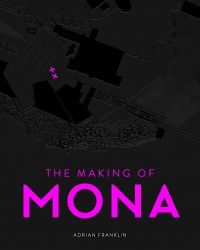- Book or article
The making of MONA
By Adrian Franklin
Published by Penguin Random House Australia
ISBN 9780670077861
Book review by Andrea Bandelli, Executive Director, Science Gallery International, Dublin, Ireland
The anti-museum
Down under, in Tasmania, lies what is arguably the most revolutionary museum in the world. MONA, the Museum of Old and New Art, is a museum that defies all that we usually associate with museums: labels, maps, authority, curatorial voice, and fatigue.
MONA was created in 2011 by David Walsh - art collector and professional gambler - and behind its apparent irreverent style, it actually puts in practice what many museum professionals would like to do in their own institutions. Visiting MONA is like visiting a friend’s home: you don’t find a map or labels on the wall. Instead, the first thing you see after being personally welcomed to MONA is a cocktail bar worth of the world’s best dance clubs, with eclectic furniture where you can actually sit down and play the piano if you want, and in the meantime you start to see some amazing art, theatrically lit up.
When you walk around the stunning building, there is actually a way to find out more about the art. It’s a device called the “O”, which you can also get as an app on your smartphone. For each piece you can read the “art wank”, a short essay from a scholar; the “gonzo”, usually David Walsh’s text about why he bought that piece; and a series of interviews with the artists recorded in cafes around the world. All this makes the art on display much more accessible and interesting. On the website, you can browse the collection from different categories, such as: “Has its own digestive system”; “Really brilliant titles”; “Annoys our female curators”; “Dubious moral genesis”; “Stuff David bought when he was drunk”… you get the picture. The “voice” of MONA is more like that of a friend who talks with you about their daily preoccupations with art, rather than the authority of a museum. David Walsh introduction to MONA couldn’t be more explicit: “Have fun you crazy kids. Go on, knock yourselves out.”
With a keen accent on contemporary art, there’s also a lot of science in MONA. Pieces like “Cloaca professional” confront us with a world where bacteria take over humans; “Supersymmetry” is the result of Ryoji Ikeda’s residency at CERN, working alongside the scientists on the LHC; “bit.fall” is concerned with the relationship between humans and technology and the speed of information today.
MONA has a winery and brewery on site, and food and drinks are part of the enjoyment of the collection - or even of your beloved ones, as advertised on their brochure: Looking at art used to be boring. It still is, maybe, but at least here at Mona you can get drunk and/or rage against the machine. When you’re done (with life) we can inter your cremated remains on our “death wall”. Your mourners can enjoy fine cuisine at The Source Restaurant, or party in more casual environs at our other delightful eating and drinking establishments. MONA thus takes eternity seriously: if not of their collections, certainly that of their visitors.
Behind this apparent unconventional style, there’s a systematic approach to the visitor experience. For instance, the “O” keeps track of what people see and how they visit the museum, and gives MONA an unprecedented level of detail about what visitors do when they’re inside. Visitors stay on average six times longer in MONA than other museums, and thirty percent come back after the first visit.
Many people would say that it’s worth going to Tasmania just to see MONA - and I wholly agree. However, until you do, there’s a terrific book about the history, philosophy and culture of MONA, which should be a compulsory reading for anybody working in the museum field. Written by anthropologist Adrian Franklin, “The making of MONA” gives a thorough description of why MONA came to be, how it works and why it is so successful. The book covers the organisational aspects of creating and running MONA, and describes in detail the cultural and anthropological context of why MONA exists. It explains how the irreverent and “tongue in cheek” style of MONA is actually the result of an intense process to shape an institution where the public is central. In short, it is one of the best books to understand how to bring an institution to life and create a museum for everyone.

